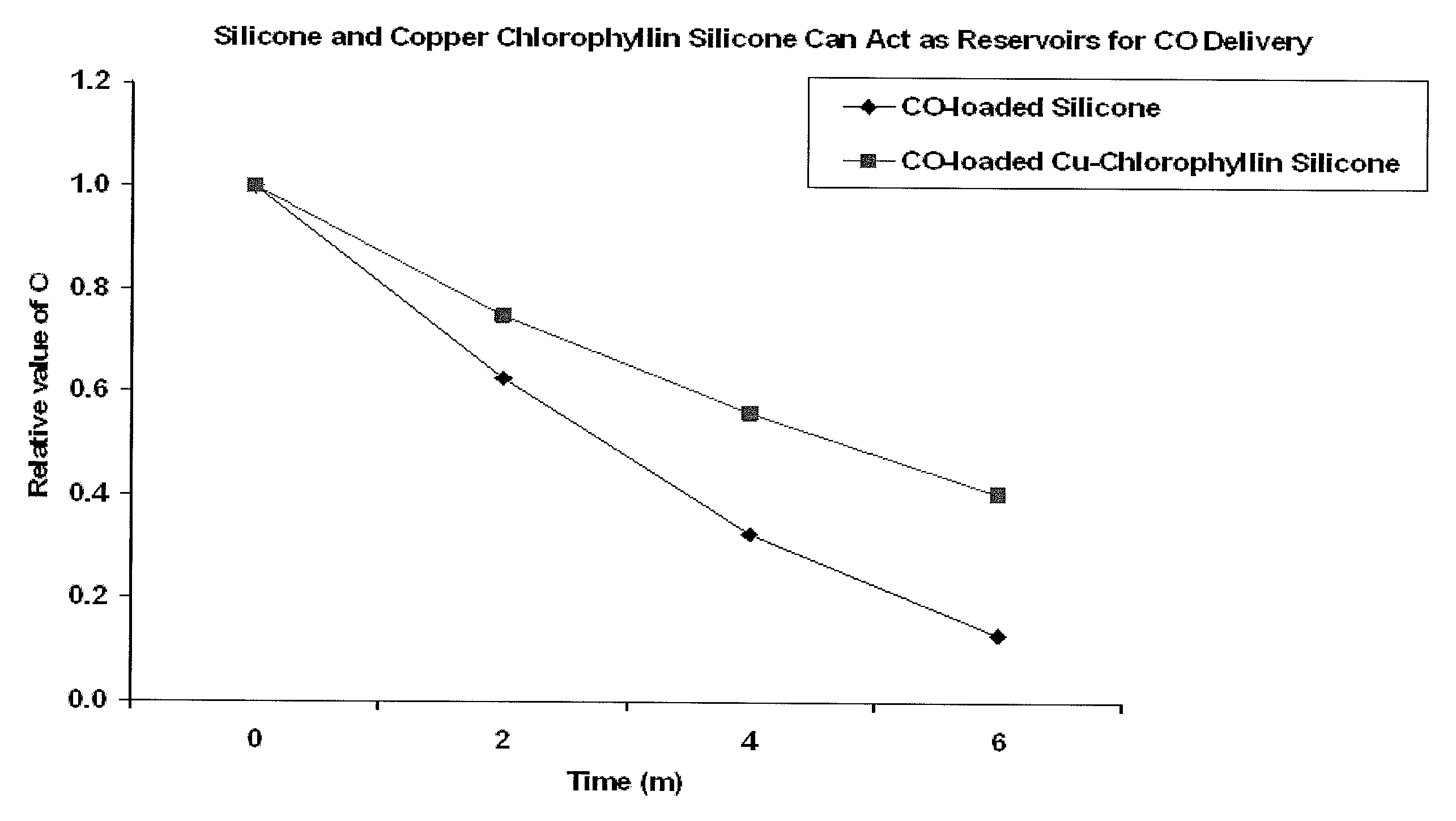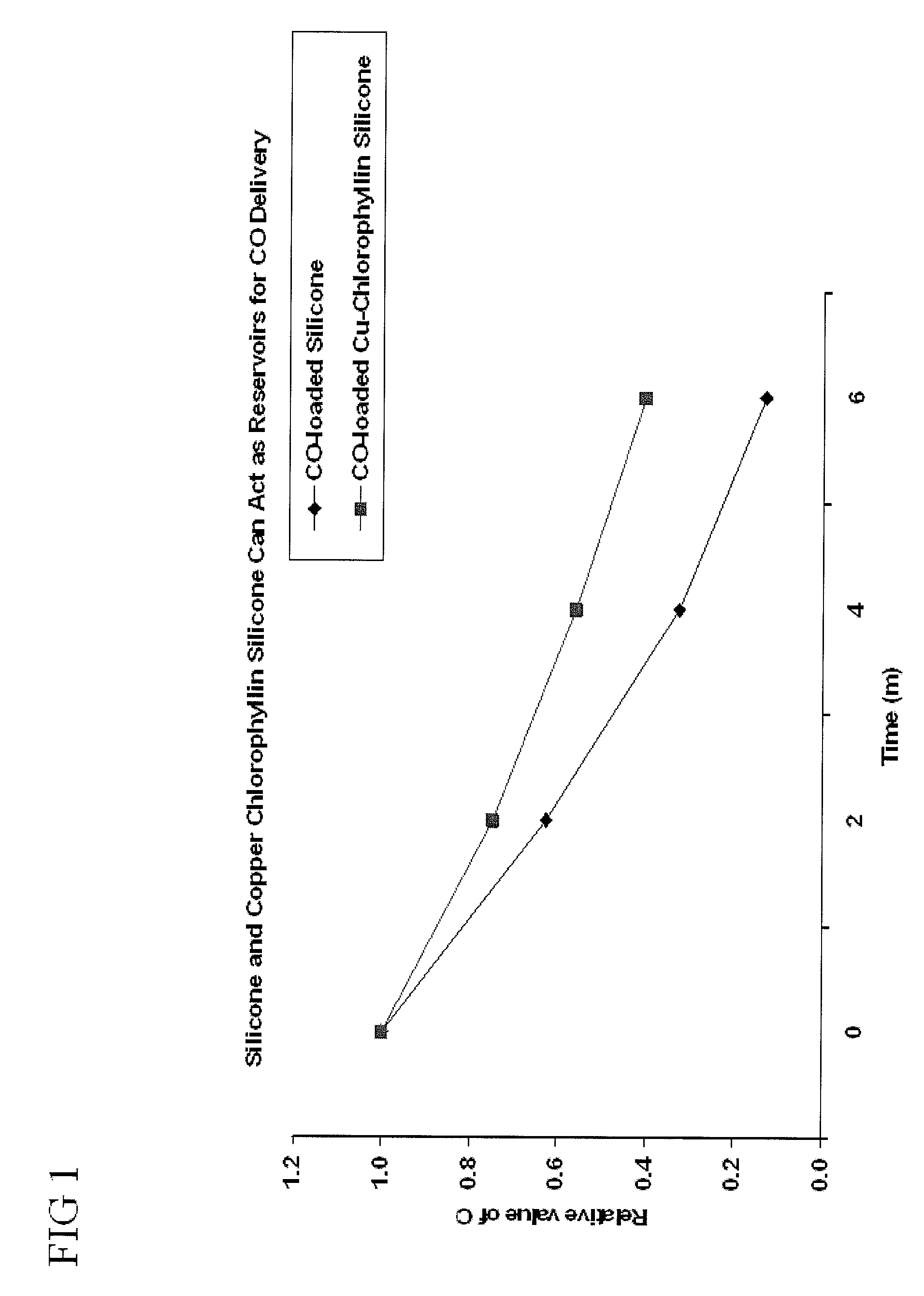Devices and methods for inhibiting fibrosis
a technology of fibroblasts and devices, applied in the field of devices and methods for inhibiting fibroblasts, can solve the problems of breast hardening, encapsulation of surgical implants complicating, and subject to a “foreign body” response, and achieve the effect of reducing or preventing fibroblast proliferation
- Summary
- Abstract
- Description
- Claims
- Application Information
AI Technical Summary
Benefits of technology
Problems solved by technology
Method used
Image
Examples
example 1
CO Material of a Solid Polymer Reservoir
[0095]It can be readily appreciated by those in the art that the type of polymer utilized can be selected based on the desired regulation of CO release and the medical use of the polymer. In one example, medical grade silicone was used. The polymer was injected into a cylindrical mold. It can be readily appreciated by those in the art that the type of mold used can be dependent of the medical use. As an alternative, the polymer can coat a medical device. The polymer sample was allowed to cure within the cylindrical mold for an appropriate amount of time. After the polymer was cured, the polymer sample was placed in a gas chamber and exposed to CO gas for CO adsorption for 72 hours. It can be readily appreciated by those in the art that the polymer sample may be placed in the gas camber for a longer period of time depending of the amount of polymer material and type of polymer material utilized.
example 2
CO Material of a Liquid Reservoir Encapsulated within a Polymer
[0096]It can be readily appreciated by those in the art that the type of polymer utilized can be selected based on the desired regulation of CO release and the medical use of the polymer. Additionally, it can be readily appreciated by those in the art that the type of CO-enhancing agent utilized can be selected based on the desired regulation of CO release and the medical use of the CO-enhancing agent. Additionally, it can be readily appreciated by those in the art that the type of liquid utilized can be selected based on the desired medical use of the liquid. In one example, medical grade silicone, copper chlorophyllin, and saline solution were used. The CO-enhancing agent was admixed with a polymer material. Five hundred milligrams of Copper chlorophyllin was admixed with 9.5 g medical grade silicone to create a 10% CO-enhancing agent embedded within the silicone. It can be readily appreciated by those in the art that ...
example 3
CO Material of a Polymer Reservoir Incorporating a CO-Enhancing Agent
[0097]It can be readily appreciated by those in the art that the type of polymer utilized can be selected based on the desired regulation of CO release and the medical use of the polymer. Additionally, it can be readily appreciated by those in the art that the type of CO-enhancing agent utilized can be selected based on the desired regulation of CO release and the medical use of the CO-enhancing agent. In one example, medical grade silicone and copper chlorophyllin were used. The CO-enhancing agent was admixed with a polymer material. Five hundred milligrams of copper chlorophyllin was admixed with 9.5 g medical grade silicone to create a 10% CO-enhancing agent embedded within the silicone. It can be readily appreciated by those in the art that the amount of CO-enhancing agent embedded in the silicone can be less than 1% to greater than 50%. The 10% copper chlorophyllin in silicone was injected into a cylindrical m...
PUM
| Property | Measurement | Unit |
|---|---|---|
| Composition | aaaaa | aaaaa |
| Permeability | aaaaa | aaaaa |
Abstract
Description
Claims
Application Information
 Login to View More
Login to View More - R&D
- Intellectual Property
- Life Sciences
- Materials
- Tech Scout
- Unparalleled Data Quality
- Higher Quality Content
- 60% Fewer Hallucinations
Browse by: Latest US Patents, China's latest patents, Technical Efficacy Thesaurus, Application Domain, Technology Topic, Popular Technical Reports.
© 2025 PatSnap. All rights reserved.Legal|Privacy policy|Modern Slavery Act Transparency Statement|Sitemap|About US| Contact US: help@patsnap.com



